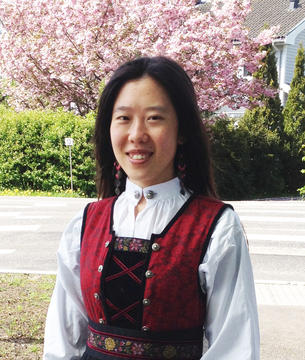Graden avlegges ved Universitetet i Sørøst-Norge (USN), Fakultet for teknologi, naturvitenskap og maritime fag.
Om avhandlingen
I have studied how one can create nanoscale patterns on a TiO2 surface, and use this to split water into oxygen and hydrogen using visible solar light.
By optimising the nano pattern created in the TiO2 surface and combing this with depositing very small amounts of Au, my research has shown that we can increase the efficiency of the hydrogen production by a plasmon-assisted photoelectochemical process.
Photoelectrochemical hydrogen production by splitting water is a promising technology that could provide a clean and cost-effective energy carrier, and modified TiO2 nanotubes is an ideal candidate to be photocatalyst in the process.
In our work, TiO2 nanotube is synthesized by electrochemical anodization. The mechanism of electrochemical anodization is first discussed, followed by control of nanotube dimensions and phases via varying anodization conditions and post-annealing process.
Subsequently, the introduction of Au nanoparticles through magnetron sputtering is described. Photocurrent density has been enhanced by a factor of 5 on Au-coated TiO2 nanotubes as compared to pristine TiO2.
Such increase in photocurrent is attributed to surface plasmonic resonance (SPR), which is proven to be effective on enhancing photoactivity and improving charge transfer property of the photoelectrode.
SPR effect is further studied by combining numerical simulations with experimental work.
The good qualitative match between simulation and experimental results indicates the validity of our numerical method.
Such strategy is then adapted to study of a novel Au-nanodisk embedded TiO2 nanohole array structure.
Results show that the proposed Au/TiO2 nanostructure can greatly increase light absorption in the visible light region for incident angle of 0 to 45 degree.